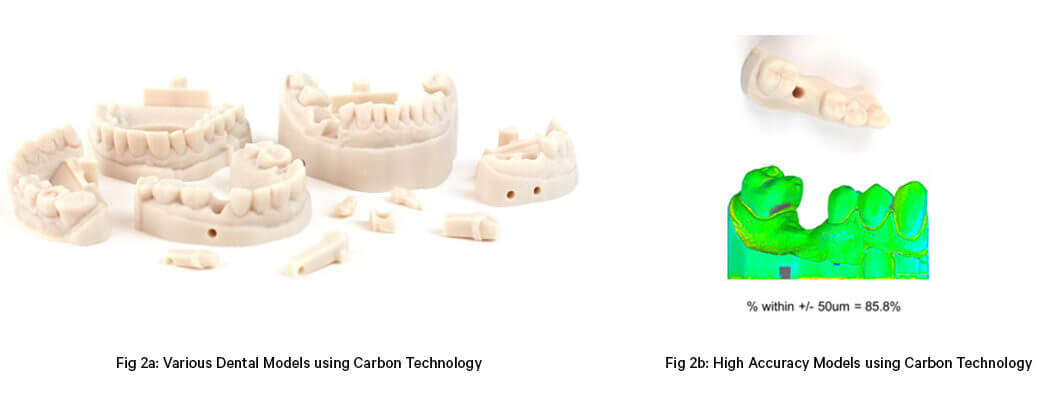Carbon’s Digital Light Synthesis™ process used with our DPR10 resin is capable of 3D printing accurate, high-quality dental models ~10 times faster than other methods. Further, Carbon’s technology offers excellent ease of use and best-in-class printer uptime. In this paper, we discuss key challenges that dental and orthodontic lab managers are currently facing and how Carbon’s M-series printers and dental resin help solve them.

CUSTOMER CHALLENGES
At Carbon, customers come first and we thrive on solving tough problems. After speaking with more than 40 dental and orthodontic labs, we synthesized the top-3 challenges labs have with existing 3D printing solutions in the market:
Slow Cycle Times: Labs are currently struggling with lengthy 5 to 8-hour print times with existing 3D printing technologies. Although multiple dental models can be 3D printed at the same time, the cycle times are still constrained by the long print times. Additionally, for some existing solutions in the market, post-print processing times can be as long as 60 minutes per quad model.
Complex Hardware Design/Use: Dental and orthodontic labs embraced digital technologies for dental model making long before other industry verticals. However, labs are struggling to keep up with the complexity of hardware, software, and resins used in existing technologies. Ease of set-up and an intuitive user interface are some of the key challenges that labs are facing.
Insufficient Service & Support: 3D model making helped solve a genuine problem in the dental world. As a result, many printers were installed rapidly as labs adapted to leverage these printing resources. Unfortunately, legacy technologies often have unacceptable downtimes with poor service and support. This means that dental and orthodontic labs are spending significant time on printer upkeep instead of printing actual dental models. Insufficient service and support mean lower printer uptime, and the issue will only escalate with time as existing hardware ages.
SOLUTION DETAILS
Powered by our Digital Light Synthesis technology, Carbon’s M-series printers—combined with our newly launched DPR resin—solve all of these customer pain points. Digital Light Synthesis technology is a breakthrough additive manufacturing technology pioneered by Carbon in 2015. Digital Light Synthesis is enabling customers across multiple industry verticals to manufacture high-performance, durable polymer products at unmatched speeds and quality.
Carbon’s proprietary Digital Light Synthesis technology is fundamentally faster compared to any other additive technology in the market. This speed benefit translates exceptionally well for dental model printing, delivering accurate, high-quality models across multiple builds (Figure 2a and 2b).

Accurate dental model creation is also enabled through Carbon’s advanced software, which brings our hardware and materials together to create a repeatable and scalable print solution. As part of our subscription model, customers always have the latest version of our software with all the latest features. Additionally, integration with existing dental specific CAD software solutions ensures that Carbon’s solution works with minimal training for most customers.
KEY BENEFITS
Let us summarize the key benefits of printing on Carbon M-series printers and how they address the top 3 challenges of dental and orthodontic laboratories around the globe:
10X Faster Cycle Times: Carbon’s Digital Light Synthesis technology is fundamentally faster. Based on initial estimates, labs can expect a ~10X improvement in print times. Faster dental models would be achievable for all Carbon lab partners. This paradigm shift in speed results in happy customers for not only dental labs but also dentist offices. Additionally, speed-up translates to better throughput per day and a lower cost per part for dental and orthodontic labs.
Simple, Easy-to-Use: Carbon’s hardware and software were designed from the bottom-up with customer needs in mind. This customer-first approach means that our hardware and software are simple, intuitive, and easy to use. Further, the small footprint of our printers helps labs to use the same space for multiple printers and thus support more customers. Additionally, the internet connectivity of Carbon’s printers means that labs always have the latest software version, which ensures the highest accuracy for dental models.
Predictive Service & Support (All Inclusive): Carbon’s customer-first philosophy translates into a customer partnership relationship model. While in the past labs have struggled with printer reliability, Carbon printers have best-in-class uptime and come with all-inclusive service and support. Our internet-connected printers proactively share performance issues with Carbon technical partners who help schedule preventative maintenance. Carbon technical partners offer dedicated guidance, quick turnaround on repairs, and support for customers to ensure that labs succeed.
KEY FEATURES
In addition to the benefits above, printing using Carbon’s DPR resin on our M-series printers offers the following features that dental and orthodontic labs prefer:
· Great resolution
· Stone color
· Excellent surface finish with fewer striations – ideal for thermoformed aligners
CONCLUSION
Dental and orthodontic labs embraced 3D printing technologies to provide a great end-consumer experience. However, based on our research, it is clear that labs are currently struggling to extract maximum value from these investments. If you are a dental or orthodontic lab now looking to fundamentally improve the speed of your business through operational efficiency with 10X faster print cycle times, best-in-class printer up-time, and exceptionally accurate dental models – please learn more about Carbon’s M-series printers at https://carbon3d.com/materials/dental or contact our sales team at dental@carbon3d.com

